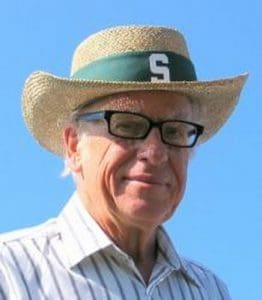How one scientist’s research led to innovative solutions for crops
Weeds have been the bane of farmers’ existence since the first agricultural seeds took root.
Throughout history, countless strategies have been deployed to keep these unwelcome invaders from edging out valuable crops. Perhaps the most powerful weapons have been herbicides.
But regardless of how effective herbicides may be, they come with their own problems. And scientists — including Dr. Donald Penner, professor in Michigan State University’s Department of Plant, Soil and Microbial Sciences — are in perpetual search of solutions.
Dr. Penner and his adjuvants

Penner has had a long career researching ways to enhance herbicides. In the 1980s, he started working with adjuvants — additives used to optimize the performance of herbicides and other agricultural active ingredients.
In the late 1990s, he invented and patented a high-fructose adjuvant that allowed farmers to reduce the amount of herbicide they applied to their fields. A second use of the adjuvant could enhance the performance of the herbicide. By mixing the two solutions and spraying the same amount of the herbicide onto the fields, farmers could up the effectiveness of the herbicide.
Penner’s high-fructose adjuvant patent was licensed by Winfield Solutions by MSU. The royalties earned from this agreement were distributed to the College of Agriculture and Natural Sciences, the inventors, and the MSU Foundation, as prescribed by MSU’s Patent Policy.
“The really important thing is getting the technology out of the university and into use where it can benefit the public,” said Tom Herlache, a technology manager from MSU Technologies.
“The royalties are the icing on the cake.”
The university and MSU Foundation shares of the royalties are typically used to support additional research and commercialization efforts, perpetually refreshing the cycle of innovation.
The dicamba problem
In the early 1970s, the agricultural company Monsanto developed glyphosate (better known as Roundup), a nonselective herbicide designed to kill weeds that compete with crops. As time passed and more farms started using glyphosate, weeds adapted to the herbicide and it stopped killing them. Farmers needed a new solution to rid their fields of weeds.
Enter dicamba, an old herbicide that could target these glyphosate-resistant weeds. When applied, dicamba helps control and suppress the growth of broadleaf weeds. Broadleaf weeds are an especially tough problem for soybeans, which are also broadleaved and sensitive to the same herbicides used to target the invasive weeds. Therefore, dicamba must be applied to dicamba-tolerant crops or it can kill the crops along with the weeds.
However, a gene can be added to crops to make them dicamba-tolerant and, recently, dicamba-tolerant soybeans were released. When dicamba is combined with glyphosate, the stacked herbicides provide excellent weed control for many of the glyphosate-resistant weeds.
As dicamba grew in popularity, a new problem emerged. While dicamba was especially popular among soybean farmers growing dicamba-resistant soybeans, their neighbors were not as thrilled with the herbicide. Dicamba is a volatile substance, meaning it evaporates easily at normal temperatures. For up to five days after application, dicamba can evaporate from the leaves and soil and drift to neighboring farms, harming dicamba-sensitive crops such as tomatoes and grapes or even nonresistant soybeans.
As not all farms can be expected to grow dicamba-resistant crops — and dicamba users wanted to continue using the herbicide to control the weed populations on their farms — the question became: How can off-target dicamba movement be reduced?
This is a question Penner has been pondering since the ’90s.
The dicamba adjuvant
Penner used the royalties from his previous licensing agreement with Winfield to fund his dicamba research.
“My goal was to find something that could destroy the dicamba vapors,” Penner said. “By destroying the herbicide in those vapors, we could start solving the problem of it moving over to the nontarget plants.”
Velsicol, the company that patented dicamba in 1962, had little success trying to reduce the volatility of the herbicide. Over 50 years later, Penner created an adjuvant that significantly reduces dicamba’s volatility.
“We have data that shows that by adding riboflavin to the spray solution, we can reduce the amount of vapors that can come off of the leaves and hit a nontarget plant and injure it,” Penner said.
Additionally, riboflavin — or vitamin B2 — allows dicamba vapors to be destroyed in sunlight. This adjuvant can also be applied to non-dicamba-resistant crops for extra protection against dicamba drift.
Adjuvants Plus Inc.
The dicamba degrading additive system discovered by Penner is patent pending. Once his innovation is patent protected and development trials are complete, supplying it worldwide will be of primary importance.
“Don’s super supportive of tech transfer,” Herlache said. “He enjoys seeing his ideas out there in use in the world. He does a lot of basic science, but he also likes to see his science applied.”
Adjuvants Plus Inc. is a Canadian agricultural company dedicated to developing innovative solutions to the problems farmers face. CEO Bill Brown met Penner more than 20 years ago, and they have had a working relationship ever since.
“Don and I have been cooperating in research for years, and I appreciate his brilliance,” Brown said.
When looking to license the dicamba adjuvant, the mission and work of Adjuvants Plus fit with Penner’s own.
The team at Adjuvants Plus is planning a series of field trials before finishing the development of the adjuvant and taking it to market.
“Adjuvants Plus is excited about this product, I think they’re going to really market it well,” Herlache said.
To learn more about Penner’s patent, check out the description here.
